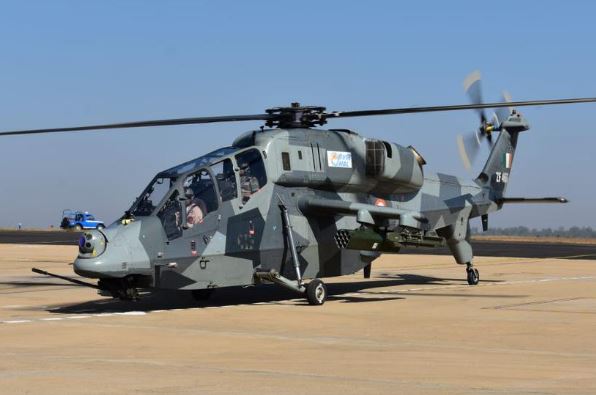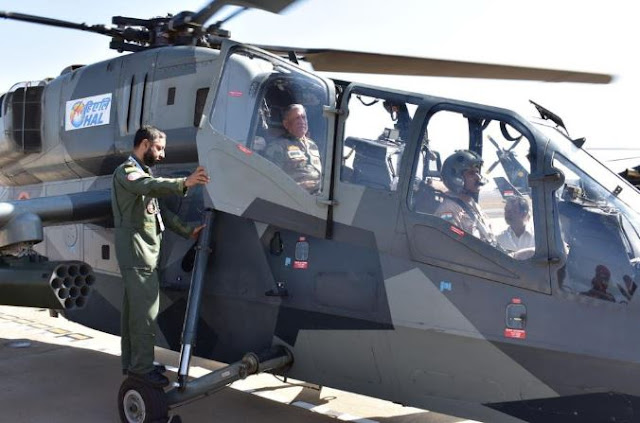HAL LCH Specs, Engine, Cockpit, and Price – HAL Light Combat Helicopter (LCH) was designed and developed by Hindustan Aeronautical Limited (HAL). This is an attack helicopter from the existing Dhruv helicopter. HAL LCH can be used in a variety of roles, including tracking slow-moving air targets, rebellion, destroying enemy defenses, search and rescue, anti-tank and scouting. The data link system transmits mission data to cellular platforms and earth stations that operate in the network.
The construction of the HAL LCH began in 2006, and was approved by the Government of India in the same year. The first LCH prototype was exhibited at the Aero India Show in 2007. The helicopter successfully completed flight tests in March 2010, which included low speed and low altitude trajectories. HAL LCH has been operating with the Indian Air Force since 2013.

HAL LCH is powered by two Turbomeca Shakti turboshaft engines. Each engine can produce an output power of 871kW. Each engine weighs 205 kg and has an output speed of 21,000 rpm. Helicopters can fly for up to 3,000 hours without maintenance.
The Turbomeca Shakti engine received the European Aviation Safety Agency certification in 2007. The machine has a Full Authority Digital Electronic Control system, which reduces pilot work by automatically calculating engine cycles.
HAL LCH can fly with a maximum speed of 275 km/ h and a maximum cruise speed of 260 km/h. Its speed which never exceeds is 330 km/ h. The helicopter can climb at the rate of 12 m/s to reach a height of 2,743 m. The helicopter has a 6,500 m service ceiling and a ferry range of 700 km.

HAL LCH is equipped with a range of advanced sensors including a device camera that is incorporated with a charge, a forward-looking infrared camera and a laser pointer. Both cameras capture enemy location and position, ensuring clear visibility during bad weather conditions. Laser range-finder and designator directs laser-guided bombs and missiles towards the target. The helicopter is also equipped with radar and laser warning receivers, missile approach warning systems, dispensing control systems and missile jammers.

The Indian Air Force ordered 64 HAL LCH as part of a 4 billion dollar contract signed with Hindustan Aeronautics in March 2011. The helicopter will be armed with Helina missiles with a range of 7km, a missile warning system and anti-missile countermeasures. Deliveries began in 2013.
The construction of the HAL LCH began in 2006, and was approved by the Government of India in the same year. The first LCH prototype was exhibited at the Aero India Show in 2007. The helicopter successfully completed flight tests in March 2010, which included low speed and low altitude trajectories. HAL LCH has been operating with the Indian Air Force since 2013.

HAL LCH Specs and Engine
HAL LCH was designed as an anti-infantry and anti-tank helicopter. The helicopter propulsion system includes a main rotor of 13.3 m in diameter and a tail rotor of 2.05 m in diameter. The LCH landing system is equipped with an anti-shock tricycle landing gear that can absorb shocks when the helicopter lands. This helicopter is equipped with Dhruv flight and hydraulic controls.HAL LCH is powered by two Turbomeca Shakti turboshaft engines. Each engine can produce an output power of 871kW. Each engine weighs 205 kg and has an output speed of 21,000 rpm. Helicopters can fly for up to 3,000 hours without maintenance.
The Turbomeca Shakti engine received the European Aviation Safety Agency certification in 2007. The machine has a Full Authority Digital Electronic Control system, which reduces pilot work by automatically calculating engine cycles.
HAL LCH can fly with a maximum speed of 275 km/ h and a maximum cruise speed of 260 km/h. Its speed which never exceeds is 330 km/ h. The helicopter can climb at the rate of 12 m/s to reach a height of 2,743 m. The helicopter has a 6,500 m service ceiling and a ferry range of 700 km.

HAL LCH Weapons
HAL LCH can be armed with electronic warfare systems and sophisticated weapon systems, including a 20 mm M621 twin-barrel cannon mounted on the chin on the Nexter THL-20 tower, 70 mm rockets, MBDA air-to-air, air-to-surface and anti-missile-radiation, and Helina-guided anti-tank missiles. Weapons of the explosion included an iron bomb, cluster bomb and a grenade launcher.HAL LCH is equipped with a range of advanced sensors including a device camera that is incorporated with a charge, a forward-looking infrared camera and a laser pointer. Both cameras capture enemy location and position, ensuring clear visibility during bad weather conditions. Laser range-finder and designator directs laser-guided bombs and missiles towards the target. The helicopter is also equipped with radar and laser warning receivers, missile approach warning systems, dispensing control systems and missile jammers.

HAL LCH Cockpit
HAL LCH has a glass cockpit that holds two crew members with a tandem configuration. The crew consists of a pilot and a shooter. The cockpit is equipped with a multifunctional LCD, target acquisition and appointment system, and digital video recorder to capture battlefield recordings for use in debriefing. The target system mounted on the helmet controls the turret gun mounted on the helicopter body.HAL LCH Price and Orders
The price of the HAL Light Combat Helicopter (LCH) is around US $ 20.2 million. The Indian Air Force and the Indian Army have ordered 62 and 114 units of LCH, respectively. The first flight took place in Bangalore in March 2010.The Indian Air Force ordered 64 HAL LCH as part of a 4 billion dollar contract signed with Hindustan Aeronautics in March 2011. The helicopter will be armed with Helina missiles with a range of 7km, a missile warning system and anti-missile countermeasures. Deliveries began in 2013.
HAL LCH Specs, Engine, Cockpit, and Price
 Reviewed by Admin
on
01:00
Rating:
Reviewed by Admin
on
01:00
Rating:
 Reviewed by Admin
on
01:00
Rating:
Reviewed by Admin
on
01:00
Rating:






No comments: